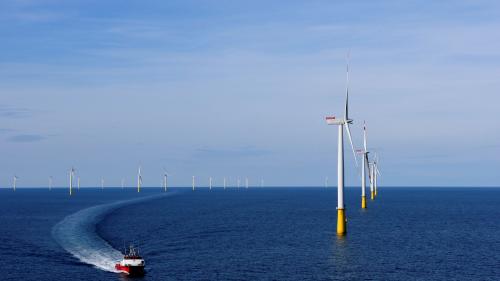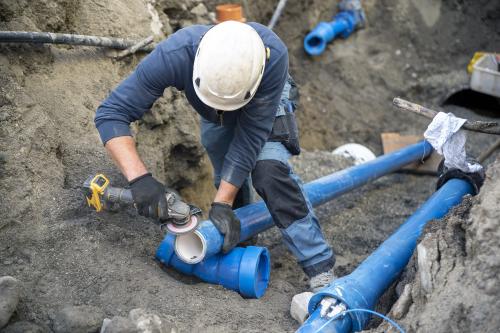Right now, it is hard to get a sense of where federal leaders stand on jumpstarting U.S. infrastructure investment. President Trump continues to propose the biggest single rebuilding program since the days of the Eisenhower administration. However, Congressional leaders are facing a packed legislative calendar and multiple reports suggest they could punt infrastructure—including a much-promised “infrastructure bill”—into 2018.
All this confusion makes total sense when you stop to think about it, though—because there is no such thing as a federal “infrastructure bill.”
We appreciate President Trump’s siren call to rebuild American infrastructure, and we share his belief that modernizing our roads, pipes, and dams will boost national competitiveness and improve quality of life. But undertaking such a grand construction program—and doing it well—will require more than a promotional campaign or a new federal financing credit. Until Congress decides what they want to build and how they’ll pay for it, we don’t see a major infrastructure bill passing anytime soon.
The first roadblock to a single bill starts on Capitol Hill: not with who we elect to office, but how the body manages the infrastructure super sector. Traditionally, Congress uses separate authorizing legislation for each category of infrastructure: surface transportation, air transportation, water resources, telecommunications, and energy. Congressional committees mirror this stratified approach, with more than half a dozen standing committees in each Congressional chamber claiming at least some responsibility for infrastructure design and oversight.
Which leads to the second roadblock: drafting specific criteria to choose projects and compete for limited funding. What’s more valuable to the U.S. economy—a new bridge or a rebuilt dam? Should we expand rural broadband deployments or improve seawalls in major metro areas? Our existing models to compare costs and benefits are not prepared for these kinds of cross-sector evaluations. Moreover, the wide variety of roles and responsibilities across different federal agencies, from U.S. DOT to EPA, can lead to competing priorities and complicate matters further. Without clear criteria, each infrastructure sector will resort to political posturing and rhetorical arguments to maximize their funding slice.
And this might be the biggest roadblock of all: the money. For all the talk of investing in American infrastructure—from both sides of the aisle—there is still no consensus about how to fund a single, aggregate strategy. Based on Congress’ surface transportation fights between 2005 and 2015, where a refusal to hike the gas tax made it difficult to pass a long-term bill, it will be impossible to move a bill without substantial new funding.
Simply put, there is a reason Congress and the Executive Branch split-up infrastructure activities—they are not that comparable. Each sector has its own planning ambitions, construction methods, governance challenges, and funding streams. Developing a single “infrastructure bill” would require a Congressional Tower of Babel.
Of course, the Trump Administration could try to sidestep many of these complexities by relying heavily on private-sector involvement and using the U.S Department of Treasury as the primary agency touchpoint. After all, letting the private sector decide which projects get built and where that work takes place is the spirit of the Trump campaign’s proposal for construction-focused tax credits, co-authored by new Commerce Secretary Wilbur Ross.
But this approach has already run into a political buzzsaw. To make private infrastructure construction and operation pencil-out, financiers need to find durable revenue streams to offset their large capital outlays. However, many parts of the country do not maintain the population levels or economic activity to create investor confidence, and many projects—from public transit to water—are structured to provide more of a public benefit than a pure private-sector return. As a result, rural and urban representatives alike already questioned this exclusive approach.
There are other ways to design a single infrastructure package, but none seem palpable in the current political environment. The 2009 Recovery Act funded a broad suite of infrastructure programs, touching on both traditional categories as well as more broadly defined infrastructure like child development centers. But the Republicans spent the last 8 years haranguing the program’s design and its impact on the federal debt. It is hard to imagine the party doing an about-face and suddenly passing their own version.
A national infrastructure bank could split the difference, leveraging the advantages of a private financing model but keeping project selection at the federal level. But here, too, the initial capital to get the bank started would either add to the debt or lead to even more complicated questions during large-scale tax reform. Even if legislators solved that puzzle, they’d still need to design project selection criteria that encompasses all infrastructure categories.
Add it all up, and an all-inclusive infrastructure package feels like short-term fantasy.
Instead, we recommend legislators and the administration take advantage of broad public support to construct a national policy step-by-step, bill-by-bill. First, federal policymakers need to establish clear objectives for the country. We recommend prioritizing maintenance and connecting people and businesses to economic opportunity. Second, leadership should explore more sustainable, cost-effective strategies to invest in infrastructure, including flexible approaches like Build America Bonds. Finally, this is an invaluable opportunity to improve data collection, update performance measures, and democratize that information to the public. We can modernize our management systems at the same time we modernize our infrastructure.
And here’s the thing—there’s no need to rush. Infrastructure lasts for multiple generations, and it often takes years to complete projects. Most agencies do not even have key political appointees in place yet, creating a leadership vacuum. We also can bundle separate bills into one package, and use extra planning time to find extra funding and not force collaborations that don’t make sense.
The Trump administration and Congress are better served to take their time, design policies that work for the whole country, and deliver projects that maximize the public good. There is a legacy to be had here, but it’ll take more than rhetoric to deliver it.
The Brookings Institution is committed to quality, independence, and impact.
We are supported by a diverse array of funders. In line with our values and policies, each Brookings publication represents the sole views of its author(s).








Commentary
At the moment, an “Infrastructure Bill” is Washington fantasy
April 7, 2017